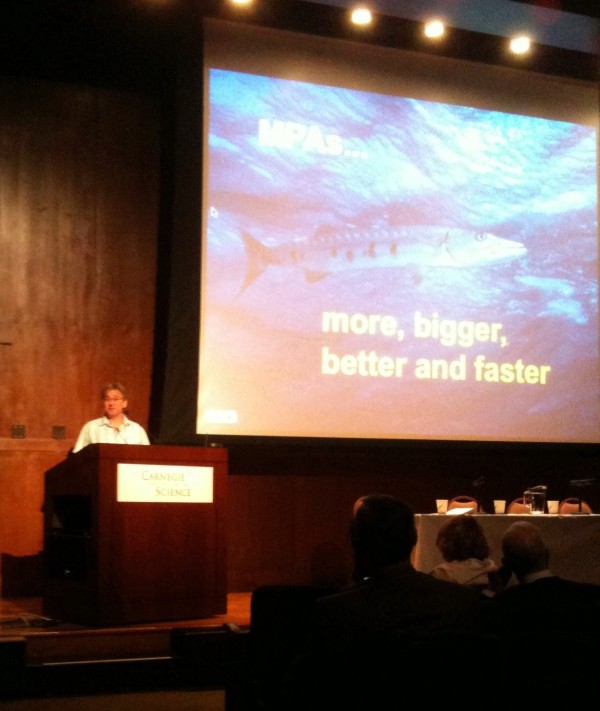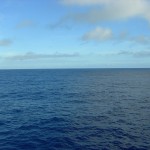![]() Get your minds out of the gutter, pervs! We are talking about marine protected areas (MPAs) here!
Get your minds out of the gutter, pervs! We are talking about marine protected areas (MPAs) here!
I’m fresh back from a quick trip to DC where I attended the 2010 Kathryn Fuller Science for Nature Symposium. This year’s topic was right up my alley… New Perspectives on MPA Performance: Linking Knowledge to Action. Organized by WWF and hosted at the beautiful Carnegie Institution for Science, the symposium drew conservation practitioners from around the world to discuss what we know and (perhaps more importantly) what we need to know about MPAs as a conservation and resource management tool.
I was happy to see many of my colleagues from DC as well as Indonesia, the Philippines, the Caribbean, and from as far as Eastern Africa in attendance. And the entire proceedings were webcast around the world for those unable to attend. In fact, I was delighted to see that the organizers paid more than just lip service to online participation by proactively drawing webcast participant questions into each q&a segment.
So what did we learn? Well, if we were looking for validation of MPAs as effective tools, we came to the right place. From Prof. Callum Roberts keynote intro and call for more MPAs, “More, Bigger, Better, Faster!”, to Sylvia Earle’s keynote closing where she debuted never-before seen hypothetical maps of the oceans at 15%, 30%, and 50% protection, this was an exciting meeting.
The most frequently cited study, Biological effects within no-take marine reserves:
a global synthesis, a meta-analysis of 149 peer-reviewed scientific publications published between 1977 and 2006 of 124 different marine reserves located in 29 countries, demonstrated that the abundance, diversity, biomass, and size of fishes, invertebrates, and seaweeds increase dramatically (sometimes increasing 10 or 20 times) inside marine reserves.
 The papers’ lead author, Dr. Sarah Lester from the University of California, Sana Barbara, presented a drill-down of the findings:
The papers’ lead author, Dr. Sarah Lester from the University of California, Sana Barbara, presented a drill-down of the findings:
- Biomass, or the mass of animals and plants, increased an average of 446%.
- Density, or the number of plants or animals in a given area, increased an average of 166%.
- Body Size of animals increased an average of 28%.
- Species Density, or the number of species, increased an average of 21% in the sample area.

The figure to the left from Lester’s study, appeared in no fewer than four other presentations throughout the day. Talk about the rock and roll star treatment. And justifiably so! Lester’s work creates a compelling argument for the rapid escalation of MPA creation around the globe–or to paraphrase Prof. Roberts, we need more MPAs, we need them bigger, better designed, and we need to speed-up the process.
Keep in mind that a meta-analysis is not an actual scientific study, but rather a systematic review and statistical examination of a collection of related scientific studies. As such, I tend to have an innate skepticism of meta-analysis results. We’ve all encountered troublesome meta-analyses over the years; analyses where bad studies may be included or where the data summarized may not be homogeneous.
Lester certainly cops to some of the limitations of her analysis, “We note a general lack of peer-reviewed reserve publications from certain regions of the world. Reserves exist in these locations, but it is difficult to assess whether implementation and enforcement are effective or whether these reserves can only be considered ‘paper reserves.’ “
On a separate front, Lester’s analysis appears to have a sample bias towards nearshore habitats and may not adequately address the performance of deep sea or pelagic MPAs, “The vast majority of reserves in our data set protect nearshore rocky or coral reef habitat, indicating a lack of marine reserve studies (and potentially marine reserves) in certain habitat types (e.g. soft sediment). This is particularly important for the interpretation of our comparison of tropical versus temperate reserve effects—while we have strong evidence that tropical and temperate reserves are similarly effective for reef ecosystems, we do not know whether this result holds for less structured habitat types. “
Nonetheless, Lester’s study is an important contribution that should provide a strong argument for the power and efficacy of MPAs to assist in managing marine ecosystems.
Lester, S., Halpern, B., Grorud-Colvert, K., Lubchenco, J., Ruttenberg, B., Gaines, S., Airamé, S., & Warner, R. (2009). Biological effects within no-take marine reserves: a global synthesis Marine Ecology Progress Series, 384, 33-46 DOI: 10.3354/meps08029







mantra is the right word – lets go into a trance….
Its undoubtedly the case that MPAs are part of healthy functioning marine system or seascape. However more, bigger, better and faster, without the appropriate means to monitor and mange is worse than none at all. In fact bigger is probably the worst of these qualities, since bigger does demand a more resource intensive management response. And many of the really effective MPAs are actually quite small, but well targeted. And bigger doesn’t mean better, even with major resource investments in funding the Great barrier reef Marine Park still cannot mange effectively its whole area since appropriate land-based management is critical to effective delivery of marine management – joined-upness is also crucial.
So connectivity with seascapes, but critically between land and seascapes is vital.
Thoughtful application the right size of MPAs applied in joined-up ways is actually the way forward – lets see that might be “Its not the size, its what you do with it” – yes that’s the mantra we really need!
good idea… and while we are at it, we should probably shut down the public school systems until teachers are better trained, safety of all students is guaranteed, all buildings are retrofitted and LEED certified, and dodgeball is banned from PE…
we are woefully behind EVERY target imaginable for the protection of our oceans… with the creation of Chagos MPA, we just eeked over 1% of the ocean under protection, with still far less then that receiving active management…
and yet even unmanaged/unenforced/unconnected mpas show reserve effect with depleted species rebound…
so yeah, we need bigger mpas, more of them, and we need this to happen faster… and we need to make sure that we follow-up quickly to ensure these are managed effectively too…
but we sure as hell don’t have the time to putter along at a snails pace… we have to get serious about protection and accept that it may not be “perfect,” but it’s necessary…
So, what recommendations are there, if any, for members of the general public who want to help support MPAs and the more, bigger, better, faster initiative?
great question, jrillinois!
if you happen to live in areas where MPAs exist or are proposed, make your voice heard in support of them… MPAs often face tremendous local resistance almost everywhere they are proposed… and all too often the resistance comes from those with strong extractive interests… the familiar cries of “you’re restricting access” always crop up from well-funded special interests…
as sylvia earle has been fond of reminding us, with only 1% of the oceans legislatively protected, we are selling out our oceans by capitulating to this notion that we have sufficient protected areas… i’m a strong proponent of being active locally for increased protection, management, enforcement, and ACCOUNTABILITY…
not sure quite why the semi-hysterical reaction to my measured comments based on 30 years of experience in dealing with MPAs, as well as PAs in general. I am, if you read carefully what i said not suggesting things stop but they are done in a proper way – I did not in any way invoke terrestrial molluscs and would not do so, general rates of environmental change mean we have no time to lose (having already lost a lot) and my point about bigger is not necessarily better you seem to agree with, as well as my point about management. Targets are useful in attracting public interest and attention; they are not often that useful in achieving and managing public affairs, although they are useful in achieving productivity in industrial enterprises. We need the right tools for the right purposes.
And local promotion and involvement in MPAs is absolutely the way to go and there are an increasing number of examples of MPAs coming from fishers for example, as they understand the benefits for their livelihoods of well-run MPAs. so please don’t obsess about size and % of area covered but lets work cooperatively to have a global “network that works” for the oceans, and therefore all of us.
Thanks, Rick! But as my name suggests, I’m nowhere near salt water. Must love it from afar and visit whenever I can. I’m aware of local initiatives to protect the Great Lakes, but who are the advocacy organizations having the greatest impact in creating more, bigger, better, faster MPAs? Thanks.